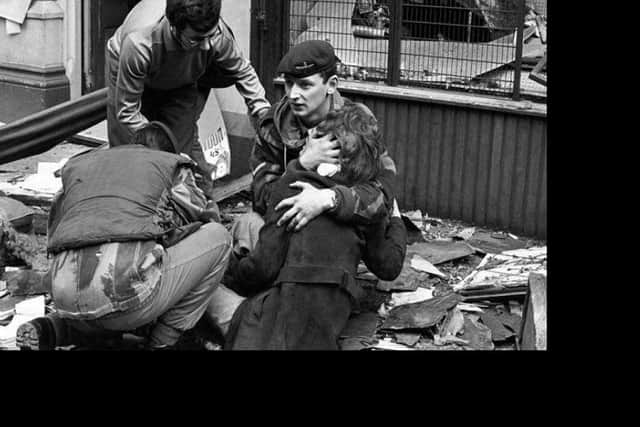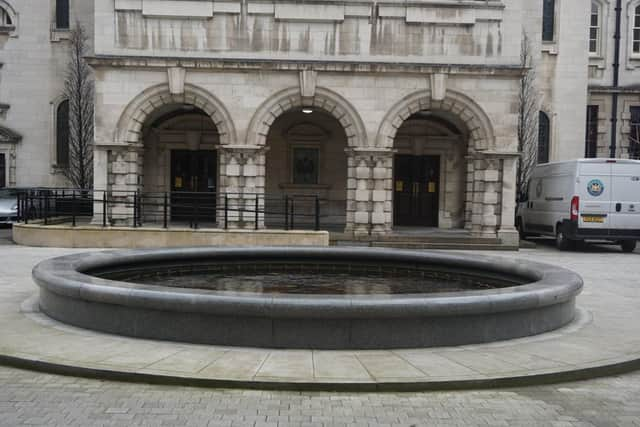News Letter bomb anniversary: Council workers murdered in terrorist attack
and live on Freeview channel 276
Three Belfast bin collectors lost their lives while working in Donegall Street on the day of the News Letter bomb in 1972.
Their sacrifice, and that of many other council employees, was finally recognised in 2009 when a fountain in their memory was created inside the grounds of Belfast City Hall.
Advertisement
Hide AdAdvertisement
Hide AdA tribute plaque on the fountain states: “This fountain is dedicated to our employees who were killed or injured at work from 1969-1999. It also recognises the contribution of all our staff who continued to deliver public services during a very difficult time.


“The water and trees symbolise hope, rebirth and a new beginning for Belfast.”
In a statement ahead of the Donegall Street bomb anniversary, Belfast Lord Mayor Kate Nicholl said: “Sadly, like so many other businesses and organisations across the city, the Troubles impacted the everyday lives of workers, including our own staff.
“A number of council employees, including these three men, lost their lives or were injured in the course of carrying out their duties and serving their community.
Advertisement
Hide AdAdvertisement
Hide Ad“It’s important that we acknowledge and remember this loss, and the devastating impact it had on their families and colleagues.


“In 2009, Belfast City Council unveiled a fountain in the courtyard at City Hall which is dedicated to all the council employees who were killed or injured at work from 1969 until 1999.”
Among the 130 people injured on March 20, 1972 was a student from Czechoslovakia who had been studying in Northern Ireland since 1969.
Blanka Suehiro (then Blanka Sochor) had fled her native country within 12 months of the Soviet Union crushing the uprising known as the Prague Spring.
Advertisement
Hide AdAdvertisement
Hide AdThe 22-year-old aspiring fashion designer had been walking on Donegall Street with the IRA bomb exploded.
In the immediate aftermath of the blast she was photographed being comforted by a soldier from the Parachute Regiment.
In June 2019, Ms Suehiro contacted the BBC in Northern Ireland in the hope they could assist her mission to track down the soldier who “risked his life” to help her fifty years ago.
“I don’t remember much about it,” she told BBC News NI.
“I don’t remember hearing the bomb, I don’t remember flying through the air. I just remember waking up in horrible pain and not really knowing what was going on.
Advertisement
Hide AdAdvertisement
Hide Ad“It was 200lbs of gelignite in a narrow street. It was mayhem everywhere.”
Ms Suehiro spent a year in Belfast’s Royal Victoria Hospital where doctors considered amputation such was the severity of the injuries.
“I don’t think I was completely together [in the aftermath of the explosion]. All I kept thinking was: ‘Please don’t cut my legs off’,” she said.
“I was very sporty, that was so important to me.”
Ms Suehiro also said she has vivid memories of another man who, along with the soldier, gave her basic first aid and remained with her until medics arrived.
Advertisement
Hide AdAdvertisement
Hide Ad“They were just talking to me, holding my hand, putting pressure on the wounds, which were mainly on my leg. Just being there for me, even though they didn’t know if there were snipers or other bombs about to explode.
“People were saying to run away, but they didn’t – they basically risked their lives for mine,” she said.
During several operations over a number of years, plastic surgeons managed to save Ms Suehiro’s legs using pioneering techniques for the time.
Although she described her memories of her time in the RVH as “blurry”, hospital staff had told her that the soldier who helped had visited her on the ward.
Advertisement
Hide AdAdvertisement
Hide AdMs Suehiro has no recollection of his visit, making her particularly keen to thank him in person.
“That’s why I’d like to track him down now - to tell him how grateful I am for what he did,” she said.
“To say thank you so much for coming to visit me and being a very kind soul.”
Ms Suehiro left Northern Ireland for Canada in 1975, where she was still living with her family in 2019 when she travelled back to Belfast in 2019 and spoke to the BBC.
Advertisement
Hide AdAdvertisement
Hide Ad“The hard part was that I couldn’t be in touch with my family because I was illegally out of Czechoslovakia, there was the Russian occupation,” she said. “But I do remember the staff at the hospital being so kind and letting me call my mum.”
In the days following the bomb, the picture of her being comforted by the soldier had appeared in a Czech newspaper – distressing her mother who recognised Blanka instantly.
Ms Suehiro has insisted that her horrific experience did not scar her emotionally, instead encouraging her to live her life to the full – acutely aware of “how short life can be” and just how close she came to death in Belfast.
She said in 2019 that she felt that a meeting with the men who treated her would bring her great comfort.
Advertisement
Hide AdAdvertisement
Hide Ad“I wouldn’t know where to start to find this soldier, but I hope I can,” she said.
Advertisement
Hide AdAdvertisement
Hide AdVictims’ group: There has been no justice, accountability or truth over the atrocity in Donegall Street in 1972
——— ———
A message from the Editor:
Thank you for reading this story on our website. While I have your attention, I also have an important request to make of you.
With the coronavirus lockdowns having had a major impact on many of our advertisers — and consequently the revenue we receive — we are more reliant than ever on you taking out a digital subscription.
Advertisement
Hide AdAdvertisement
Hide AdSubscribe to newsletter.co.uk and enjoy unlimited access to the best Northern Ireland and UK news and information online and on our app. With a digital subscription, you can read more than 5 articles, see fewer ads, enjoy faster load times, and get access to exclusive newsletters and content.
Visit https://www.newsletter.co.uk/subscriptionsnow to sign up.
Our journalism costs money and we rely on advertising, print and digital revenues to help to support them. By supporting us, we are able to support you in providing trusted, fact-checked content for this website.
Ben Lowry, Editor